

Designing for digital capabilities in the curriculum: what’s new? When we launched the digital capabilities community of practice, a whole number of people signed up for a session on developing the curriculum.
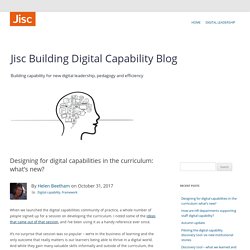
Digital Fluency: the new Librarian skill set – Jane Cowell – Medium. In the new NMC Horizon Report > 2017 Library Edition they list spreading Digital Fluency as a core responsibility of libraries.
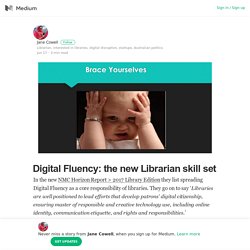
They go on to say ‘Libraries are well positioned to lead efforts that develop patrons’ digital citizenship, ensuring master of responsible and creative technology use, including online identity, communication etiquette, and rights and responsibilities.’ At my library we are embarking on developing a Digital Strategy and Margaret Warren is leading this project and our discussions really highlighted for me the opportunity for real change in library service delivery — but we need to think differently. As part of the project Margaret has immersed herself in other organisations’ digital strategies to determine the ‘good’ from the ‘bad’. 5 steps to creating a sustainable digital literacies curriculum – Medium. The following is based on my doctoral thesis, my experience as Web Literacy Lead at the Mozilla Foundation, and the work that I’ve done as an independent consultant, identifying, developing, and credentialing digital skills and literacies.

To go into more depth on this topic, check out my book, The Essential Elements of Digital Literacies. The quotation below, illustrated by Bryan Mathers, is an African proverb that I’ve learned to be true. The easiest thing to do, especially if you’re short of time, is to take a definition - or even a whole curriculum / scheme of work - and use it off-the-shelf. This rarely works, for a couple of reasons. First, every context is different.
Second, because the people within your organisation or programme haven’t been part of the definition, they’re not invested in it. Learning with 'e's: Digital literacies in the age of remix. This site uses cookies from Google to deliver its services, to personalise ads and to analyse traffic.
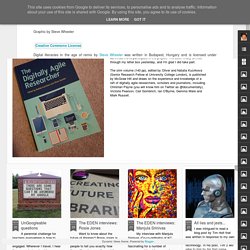
Information about your use of this site is shared with Google. By using this site, you agree to its use of cookies.Learn moreGot it About Me Steve Wheeler I'm Associate Professor of learning technology in the Plymouth Institute of Education at Plymouth University. Picture Loading. Introducing Mozilla’s Web Literacy Map, Our New Blueprint for Teaching People About the Web. Within the next decade, the number of individuals with access to the Internet will rise to five billion.
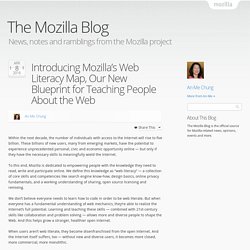
These billions of new users, many from emerging markets, have the potential to experience unprecedented personal, civic and economic opportunity online — but only if they have the necessary skills to meaningfully wield the Internet. To this end, Mozilla is dedicated to empowering people with the knowledge they need to read, write and participate online. We define this knowledge as “web literacy” — a collection of core skills and competencies like search engine know-how, design basics, online privacy fundamentals, and a working understanding of sharing, open source licensing and remixing. We don’t believe everyone needs to learn how to code in order to be web literate. But when everyone has a fundamental understanding of web mechanics, they’re able to realize the Internet’s full potential. When users aren’t web literate, they become disenfranchised from the open Internet.
10 Critical Skills You’ll Need to Succeed at Work in 2020 — Life Learning. 10 Critical Skills You’ll Need to Succeed at Work in 2020 Which skills will be most in demand in the coming years?

Digital Literacies Framework project – La Trobe University – connecting digital learning with digital fluency. Transliteracy: Crossing divides. Transliteracy might provide a unifying perspective on what it means to be literate in the twenty–first century.
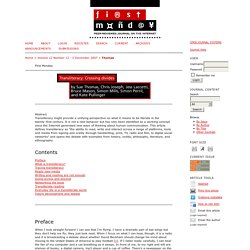
It is not a new behavior but has only been identified as a working concept since the Internet generated new ways of thinking about human communication. This article defines transliteracy as “the ability to read, write and interact across a range of platforms, tools and media from signing and orality through handwriting, print, TV, radio and film, to digital social networks” and opens the debate with examples from history, orality, philosophy, literature, and ethnography.
A Definition Of Web Literacy (And How Students Can Benefit) A Definition Of Web Literacy (And How Students Can Benefit) by Chris Lawrence, VP of Learning At Mozilla Reading, writing and arithmetic are the cornerstones of education.
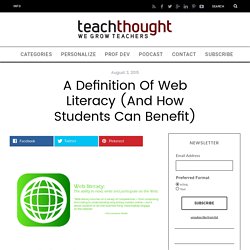
While the methods for teaching them may vary, the three Rs are timeless and universal. They equip learners with the skills necessary to interact and participate in the world. And they lay the groundwork for a set of more complex skills: critical thinking, collaboration, nonlinear thinking and others. The three Rs aren’t going anywhere. At Mozilla, we define web literacy as the ability to read, write and participate on the Web. In the 21st century, web literacy unlocks the same opportunities as reading and writing. Why Web Literacy Matters, Too — Bright. Reading, writing and arithmetic need a 21st century companion: web literacy.
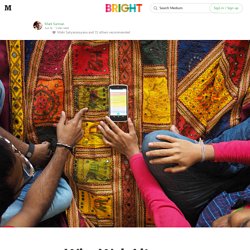
By Mark Surman On a recent Tuesday afternoon in London, I asked a simple question to a full room: “How many people think of themselves as tech savvy, or digitally literate?” Several hands shot up in response. I posed a second question: “How many people would say knowing how the Internet works has opened opportunity for them?” Here, the reaction was almost unanimous — virtually all attendees raised their hands. But the showing of hands suggested something deeper: It’s time we formally introduce web literacy into our education systems around the globe. When the modern education system first emerged, we cast a trio of skills as its bedrock: the three Rs. Timing is key. Exploring digital citizenship as a form of literacy. 6 Steps to Teaching Students to Search. Please feel free to use this resource with students or in teacher trainings.
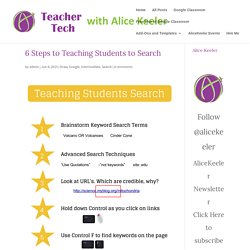
Please do not republish to your blog. Link to Google Drawing: The new literacy is to teach students how to search. Rather than giving students answers, we ask really good questions. Students then use advanced search techniques to find the answers. Students are likely going to struggle with answering essential questions. Start students off by learning advanced search techniques. These suggestions are not intended to be done in a single day unless this is the content you are teaching. Ask a good essential question that you have no intention of answering with the students. Moving Students From Digital Citizenship To Digital Leadership. Moving Students From Digital Citizenship To Digital Leadership by TeachThought Staff Digital Citizenship has become one of the more symbolic phrases that represents the significant impact technology has made on our behavior and interactions.
The Common Sense Census: Media Use by Tweens and Teens. Media Lit 101: 6 Great Videos for Teaching Media Fluency. There’s no denying the influence of digital media in our daily lives. Media consumption is everywhere, and it’s got us plugged in pretty much constantly. Our passions are shared with, our opinions are shaped with it, and our emotions are fed by it. Sometimes we control it, and sometimes—well, it kind of controls us. Mapping the Divide: Visitors and Residents on the Web – Read Write Respond. Flickr photo shared by mrkrndvs under a Creative Commons ( BY-NC-SA ) license In an attempt to make sense of the divide when it comes to the use of technology, Marc Prensky published two articles in 2001 in which he coined the terms digital native and digital immigrant.
He used this to explain the difference between those born after 1980 who have grown up with technology being in every part of their life, compared with those ‘immigrants’ who have had to pick everything up. The problem with the native/immigrant explanation is that it lacks nuance. Firstly, it assumes that if you were born after a certain time that you represent certain disposition. Secondly, it fails to recognise that our use of technology is forever changing over time. Flickr photo shared by mrkrndvs under a Creative Commons ( BY-NC-SA ) license flickr photo shared by mrkrndvs under a Creative Commons ( BY-NC-SA ) license Another dimension which White and Le Cornu add to this is the question of place.
Like this: